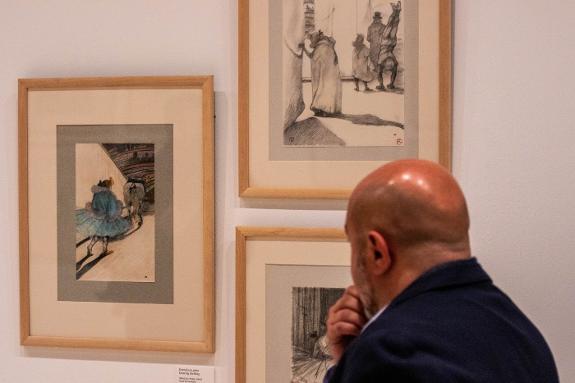

Secciones
Servicios
Destacamos

SUR IN ENGLISH
Thursday, 27 February 2020, 16:25
The life of Henri de Toulouse-Lautrec (Albi, 1864) was marked by illness since he was a child. So when he arrived in Paris he felt comfortable diving into the underworld of a city that was boiling over as it became the bourgeois icon of the late 19th century.
When. Until 7 June.
Where. Sala Noble, Museo Carmen Thyssen Málaga.
What. A collection of reproductions of Toulouse-Lautrec's circus drawings.
Prostitutes, outcasts and weirdos made him feel at home and stirred a certain fascination. When the wealthy class made the circus their favourite entertainment - the capital came to have four permanent circus rings - the painter found his own pictorial balance, devoting long hours to portraying these characters.
This series of drawings, entitled 'Au cirque' (At the circus), is on display in the Carmen Thyssen Museum in Malaga and is called 'Toulouse-Lautrec and the fabulous world of the circus'.
The exhibition was opened by the Mayor of Malaga, Francisco de la Torre, last Thursday; the councillor for Culture and Sports, Noelia Losada; the artistic director of the museum, Lourdes Moreno - who is also the curator of the exhibition - and the sponsor of the exhibition, Daniel Pastor.
The new temporary exhibition is composed of 39 prints that the painter drew in 1899 and that a group of photographers published after his death between 1905 and 1931.
In the exhibition there are also illustrations published in the press of the time and other works, such as the internationally known female clown Cha-U-Kao. All the pieces come from the collection of Jean Pierre Gimbergues.
Moreno, explained that this collection was drawn "from memory", springing directly from the memories that Toulouse-Lautrec had stored throughout the years of coexistence with the circus characters. He drew them while he was in a sanitarium in Neuilly, on the outskirts of Paris, the result of a combined complication of his illnesses and addictions. When he finished the series, he said that he had "bought" his "freedom", a kind of redemption with which he got the key to leave the sanitarium.
However, his medical condition worsened soon after and he died at the age of 31 in 1901, two years after the creation of his most famous and renowned collection.
After his death, the paintings went to his best friend Maurice Joyant, an art dealer who organised several posthumous exhibitions. It was at this stage that the technique of bichromated gum came into play, a photomechanical process implemented at the end of the 19th century that became established as a non-invasive form of image reproduction.
Publicidad
Publicidad
Publicidad
Publicidad
Esta funcionalidad es exclusiva para registrados.
Reporta un error en esta noticia

Debido a un error no hemos podido dar de alta tu suscripción.
Por favor, ponte en contacto con Atención al Cliente.

¡Bienvenido a SURINENGLISH!

Tu suscripción con Google se ha realizado correctamente, pero ya tenías otra suscripción activa en SURINENGLISH.
Déjanos tus datos y nos pondremos en contacto contigo para analizar tu caso

¡Tu suscripción con Google se ha realizado correctamente!
La compra se ha asociado al siguiente email
Comentar es una ventaja exclusiva para registrados
¿Ya eres registrado?
Inicia sesiónNecesitas ser suscriptor para poder votar.